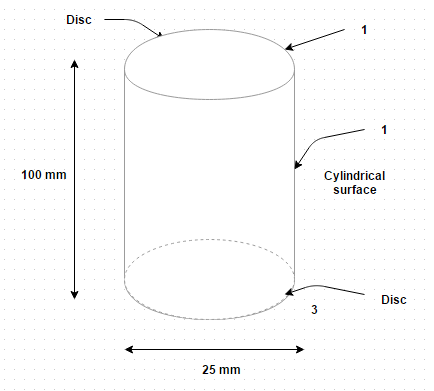This set of Heat Transfer Multiple Choice Questions & Answers (MCQs) focuses on “Gaseous Radiations”.
1. Which of the following have a continuous spectrum?
a) Solids
b) Liquids
c) Gases
d) Solids and liquids
View Answer
Explanation: They emit and absorb the radiant energy of all wavelength.
2. Which of the following is/are known as selective absorbers?
a) Solids
b) Liquids
c) Gases and vapors
d) Vapors
View Answer
Explanation: They emit and absorb radiant energy in definite parts of the spectrum called bands.
3. Which layers participated in the process of thermal radiation through solids and liquids?
a) 1 micron to 1 mm thick
b) 2 micron to 2 mm thick
c) 1 micron to 0.5 mm thick
d) 2 micron to 4.57 mm thick
View Answer
Explanation: Gases possess a much small radiating power and all their volumes participate in the radiation.
4. Some of the gases have low emissive power and absorptivity. They are considered practically diathermanous. Which of the following option is true?
a) Ammonia
b) Helium
c) Carbon-dioxide
d) Methane
View Answer
Explanation: Helium is monoatomic gas and is extremely inert to thermal radiation.
5. Consider an enclosure formed by three surfaces having the following values of shape factors, emissivities and temperatures

Surface 1 i.e. curved cylindrical has an emissivity 0.75 and temperature 800 K
Surface 2 i.e. closing disc has an emissivity 0.8 and temperature 700 K
Surface 3 i.e. closing disc has an emissivity 0.8 and temperature 700 K
The closing flat discs are 25 mm in diameter and they have interspacing distance equal to 100 mm. If the shape factor between these two identical discs is 0.05, calculate the net rate of radiant heat flow from the curve surface to each of the closing end surface
a) 1.561 W
b) 2.561 W
c) 3.561 W
d) 4.561 W
View Answer
Explanation: F 21 + F 23 + 1 and A 1 = 0.00785 m2, A2 = 0.000491 m2. Then from reciprocity theorem, F 12 = 0.0594. Q12 = F 12 A 1 σ b (T 14 – T 2 4) = 3.561 W.
6. Consider a beam of monochromatic radiation at wavelength λ that enters a layer of absorbing gas. As the beam passes through the gas layer, its intensity
a) Decreases
b) Increases
c) Become twice
d) Remains same
View Answer
Explanation: The decrease is given by d I λ X = – K λ I λ X d x.
7. When a gas or vapor is in the process of oxidation and combustion, it is called as
a) Oxidation
b) Flame
c) Reduction
d) Combustion
View Answer
Explanation: It is known as a flame.
8. The monochromatic absorption coefficient depends upon
(i) Temperature
(ii) Time
(iii) Pressure
(iv) Wavelength
Identify the correct option
a) i, ii and iv
b) ii, iii and iv
c) i and ii
d) i, iii and iv
View Answer
Explanation: It depends upon the state of gas and the wavelength.
9. Which one of the following is not extremely inert to thermal radiation?
a) Orgon
b) Oxygen
c) Methane
d) Nitrogen
View Answer
Explanation: Methane is a polyatomic gas.
10. Consider a beam of monochromatic radiation at wavelength λ that enters a layer of absorbing gas. As the beam passes through the gas layer, its intensity is given by
a) d I λ X = – K λ I λ X d x
b) d I λ X = – 2 K λ I λ X d x
c) d I λ X = – 3 K λ I λ X d x
d) d I λ X = – 4 K λ I λ X d x
View Answer
Explanation: Its intensity gets reduced.
Sanfoundry Global Education & Learning Series – Heat Transfer.
To practice all areas of Heat Transfer, here is complete set of 1000+ Multiple Choice Questions and Answers.
If you find a mistake in question / option / answer, kindly take a screenshot and email to [email protected]
- Check Chemical Engineering Books
- Check Mechanical Engineering Books
- Practice Chemical Engineering MCQs
- Apply for Chemical Engineering Internship
- Check Heat Transfer Books
